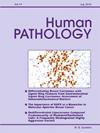CIC-rearranged sarcoma in the breast: A series of 3 rare cases with literature review
IF 2.6
2区 医学
Q2 PATHOLOGY
引用次数: 0
Abstract
Capticua transcriptional repressor (CIC)-rearranged sarcoma represents a distinct highly aggressive, undifferentiated round cell sarcomas, which most commonly affects young adults. The tumor typically arises in the deep soft tissues of the limbs and trunk, followed by the head and neck region, and is rarely found in visceral organs. CIC-rearranged sarcoma originating in the breast is extremely rare with only one case having been reported in the literature. We report three cases of CIC-rearranged sarcoma in the breast, all occurring in young females and exhibiting aggressive clinical behavior. Microscopically, all three cases showed diffuse or lobular growth of small round blue tumor cells with vesicular nuclei, prominent nucleoli, and clear cytoplasm. Focal reticular growth pattern and myxoid stroma were also observed. The diagnosis of CIC-rearranged sarcoma was confirmed through either fluorescence in situ hybridization (FISH) or RNA sequencing; two of the three cases were confirmed to harbor CIC::DUX4 fusion. This case series, to the best of our knowledge, represents the largest report of CIC-rearranged sarcoma in the breast. It highlights the importance of recognizing this rare entity in the breast due to its aggressive clinical course, poor response to chemotherapy, and high tendency for metastasis. It also emphasizes the utility of molecular studies in distinguishing CIC-rearranged sarcoma from poorly differentiated carcinoma, as CIC-rearranged sarcoma has significantly worse prognosis than poorly differentiated carcinoma of breast.
乳腺cic重排肉瘤:3例罕见病例并文献复习。
Capticua转录抑制因子(CIC)重排肉瘤是一种独特的高度侵袭性,未分化的圆细胞肉瘤,最常见于年轻人。肿瘤通常发生在四肢和躯干的深层软组织,其次是头颈部,很少发生在内脏器官。起源于乳腺的cic重排肉瘤极为罕见,文献中仅报道一例。我们报告了三例乳腺cic重排肉瘤,均发生在年轻女性,并表现出侵略性的临床行为。镜下3例均可见小圆蓝色肿瘤细胞呈弥漫性或小叶状生长,细胞核呈泡状,核仁突出,细胞质清晰。灶性网状生长模式及粘液样间质。通过荧光原位杂交(FISH)或RNA测序证实cic重排肉瘤的诊断;3例中有2例确诊为CIC::DUX4融合。据我们所知,这个病例系列是乳腺中最大的cic重排肉瘤报告。它强调了认识这种罕见的乳腺肿瘤的重要性,因为它具有侵袭性的临床病程,对化疗的不良反应,以及转移的高倾向。它还强调了分子研究在区分cic重排肉瘤和低分化癌中的作用,因为cic重排肉瘤的预后明显差于乳腺低分化癌。
本文章由计算机程序翻译,如有差异,请以英文原文为准。
求助全文
约1分钟内获得全文
求助全文
来源期刊

Human pathology
医学-病理学
CiteScore
5.30
自引率
6.10%
发文量
206
审稿时长
21 days
期刊介绍:
Human Pathology is designed to bring information of clinicopathologic significance to human disease to the laboratory and clinical physician. It presents information drawn from morphologic and clinical laboratory studies with direct relevance to the understanding of human diseases. Papers published concern morphologic and clinicopathologic observations, reviews of diseases, analyses of problems in pathology, significant collections of case material and advances in concepts or techniques of value in the analysis and diagnosis of disease. Theoretical and experimental pathology and molecular biology pertinent to human disease are included. This critical journal is well illustrated with exceptional reproductions of photomicrographs and microscopic anatomy.
 求助内容:
求助内容: 应助结果提醒方式:
应助结果提醒方式:


